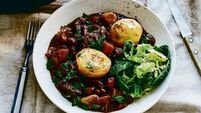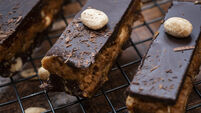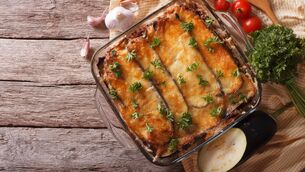Darina Allen: These three recipes are perfect examples of natural brain food
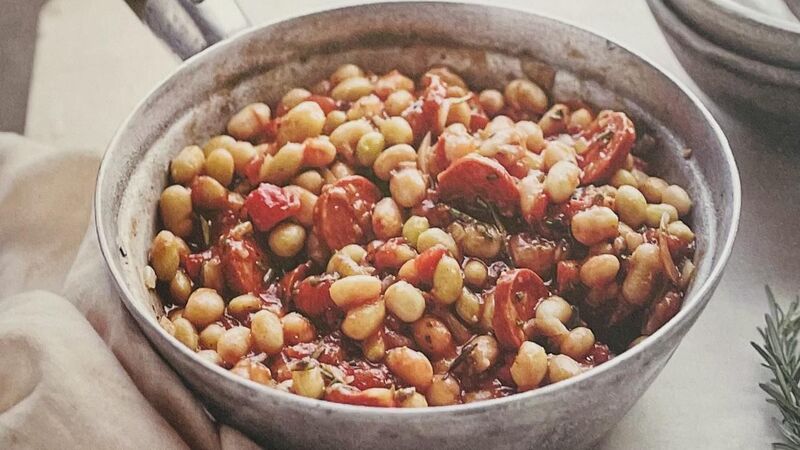
Darina Allen: How about a delicious bean stew for supper?
Don’t we all wish that there was some magic pill we could take to boost our brain power, improve our memory and prevent cognitive decline?
Well, seems like no such thing has been invented, as yet.
However, there does seem to be a certain amount of consensus about foods that actually help us rather than do damage, often the same ones that protect the heart and blood vessels.
Fish, particularly oily fish, are high on that list, brilliant sources of omega-3 fatty acids, so try to eat fish at least twice a week - and if you can’t get fresh fish, that could be canned sardines or albacore tuna (check out Aishling Moore’s column for weekly inspiration).
Sadly there were virtually no herring or sprats landed in Ballycotton this year and precious few mackerel this summer.
Flax seeds, avocados, and walnuts are all good sources of omega-3 too.
Berries, particularly blueberries and strawberries in season, are a terrific source of beneficial flavonoids.
Feast on leafy greens; kale, spinach, chard, cavolo nero and broccoli are also a rich source of brain-boosting nutrients like vitamin K, lutein, folate and beta carotene.
All in full season now, but remember the inconvenient truth - they must be organic, otherwise they are likely to contain chemical residues in abundance, unlikely to boost brain power.
Walnuts are an excellent source of protein and healthy fats, the shape even resembles the brain - lots of research to confirm this fact, apparently they are good, both for heart and brain health: just nibble or add to your breakfast granola.
Make sure they are fresh and in the shell if possible. A high percentage of walnuts, even in health food shops, are rancid, so be vigilant - they should taste fresh and sweet like they do around Halloween.
Pumpkin seeds also get an honourable mention, sprinkle over your muesli or add to breads.
Coffee also gets the thumbs-up, as does green tea. The two main components, caffeine and antioxidants help to support brain health, sharpen concentration and help to protect against Alzheimer’s and Parkinson’s.
Turmeric is a potent antioxidant and anti-inflammatory, also accompany it with a little black pepper and oil for maximum benefit and absorption.
There’s also good news for those of us who love some good dark chocolate, 70% cocoa butter or even higher. Lots of studies confirm that it is a super source of brain-boosting compounds including flavonoids, caffeine and antioxidants.
Oranges, once again organic, have high vitamin C content that reduces the free radicals that can damage brain cells.
Eggs from happy, free-range hens fed on organic food, are a superfood; and last but not least, wholegrains and pulses like peas, beans, and lentils are also associated with improving memory loss, and a lower risk of dementia.
As ever, seek out an unprocessed organic option rather than refined grains for a slow consistent release of energy and nutrients.
So there you have it. How about a delicious bean stew for supper?
A slight adaptation on a recipe from The Kai Cookook/A Love letter to the West of Ireland by Jess Murphy published by Nine Bean Rows. Servings Preparation Time Cooking Time Total Time Course Ingredients 50g salted butter 3 shallots, sliced (75g) 2 garlic cloves, peeled and smashed 600g cavolo nero, stalks removed and leaves roughly chopped (400g after stalks have been removed) 3 tbsp white wine 130g pine nuts or cashew nuts, toasted 15g fresh flat leaf parsley, chopped 1 stalk of fresh lovage, chopped sea salt and freshly ground black pepper For the PX raisins: 200g golden raisins 200ml Pedro Ximénez (PX) sherry Method Put the raisins and sherry in a small saucepan and bring to a boil, then remove the pan from the heat and set aside to let them soak and cool. Melt the butter in a large stainless wok or frying pan on a medium heat. When the butter starts to foam, add the shallots and garlic and cook for 90 seconds, just until fragrant. Add the cavolo nero and white wine and season with salt and pepper. Cook down the cavolo nero for about 5 minutes, then stir in the drained raisins, pine nuts and fresh chopped herbs (save the leftover PX sherry for a dressing with some extra virgin olive oil). Transfer to a serving dish and serve hot.Cavolo Nero with PX-Soaked Raisins and Pine Nuts
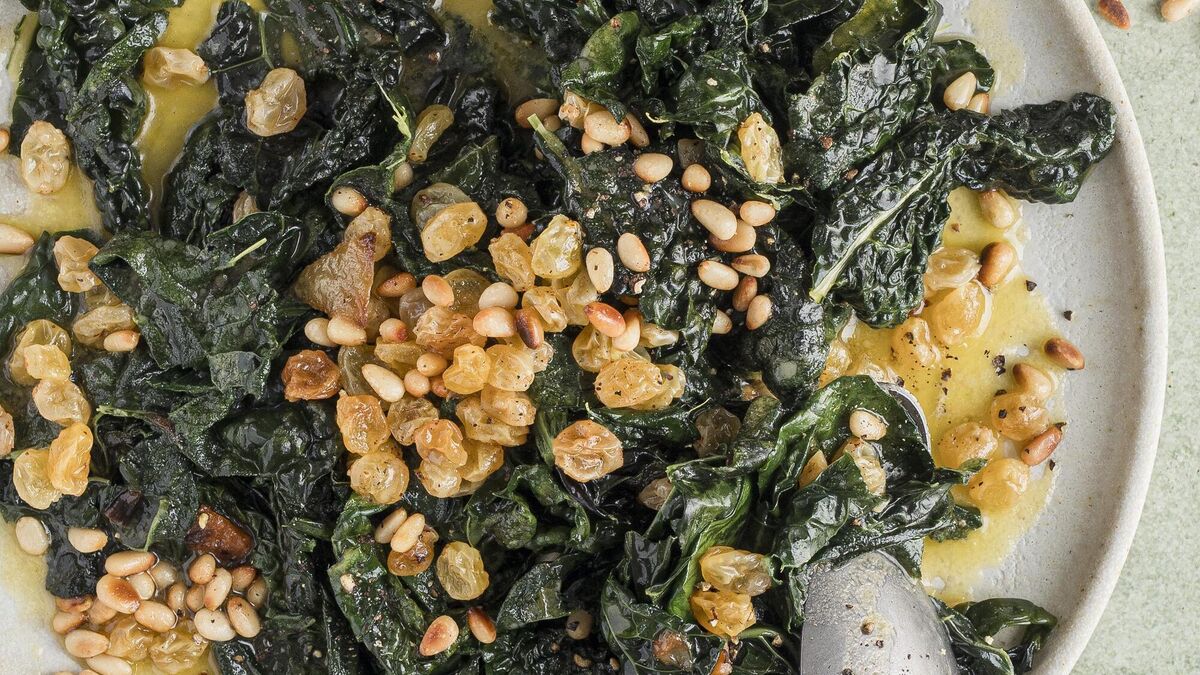
This bean stew freezes brilliantly in all its incarnations – see variations below. Serve as a vegetarian main or as a side dish to roast lamb or pork, or roast vegetables. Servings Course Ingredients 225g dried haricot beans or cannellini beans Bouquet garni made from a bay leaf, parsley stalks, thyme, celery stick (optional) 1 onion, halved 1 carrot, halved 175g chopped onion 3 tbsp olive oil 4 large garlic cloves, crushed 400g can chopped tomatoes 1-2 large sprigs of rosemary, chopped sea salt and freshly ground black pepper sugar Method Soak the beans overnight in plenty of cold water. Next day, strain the beans and cover with fresh cold water, add the bouquet garni, onion and carrot, cover and simmer for 30 minutes – 1 hour until the beans are soft but not mushy. Just before the end of cooking, add salt to taste. Remove the bouquet garni and vegetables and discard. Save the cooking liquid for later. Meanwhile, sweat the chopped onion gently in the oil in a wide saucepan for 7-8 minutes until soft but not coloured, add the garlic and cook for a further minute or two. Then add the chopped tomatoes, cooked white beans and finely chopped rosemary. Simmer for 10-15 minutes, add some of the bean liquid if necessary and season well with salt, freshly ground black pepper and sugar. The mixture should be loose and juicy but not swimming in liquid. Variations:White Bean Stew with Tomato & Rosemary
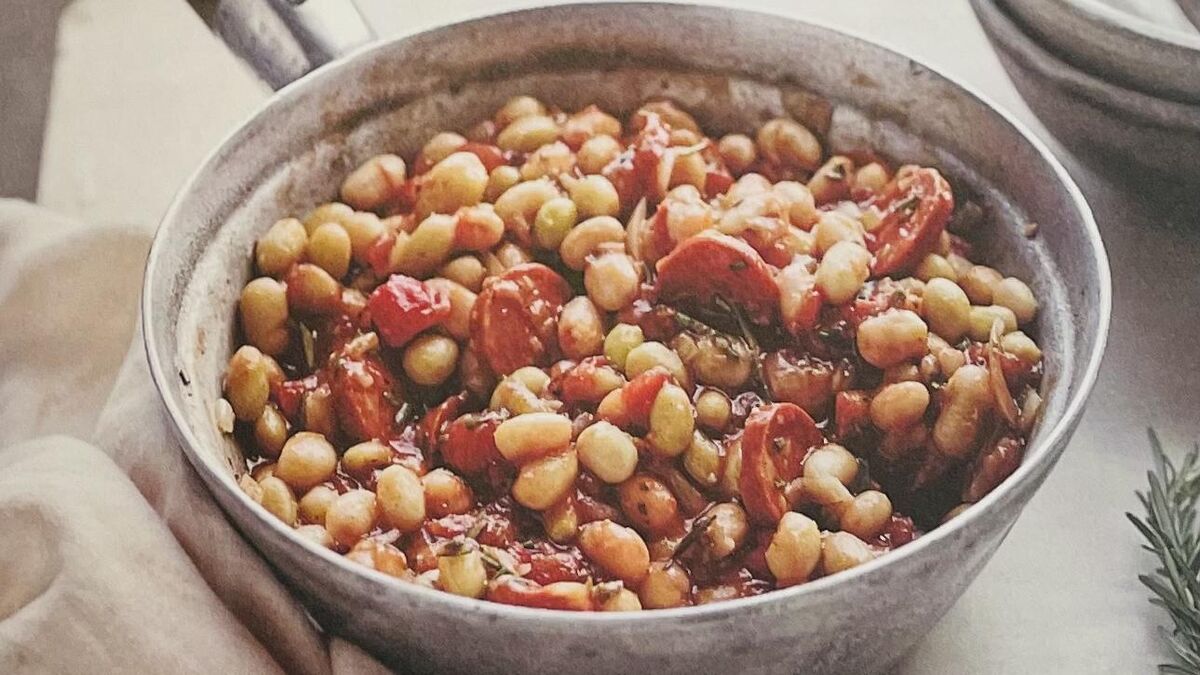
62% or 70% chocolate is called for here to give the depth of chocolaty flavour that will counteract the sugar in the caramel. Servings Course Ingredients For the chocolate mousse: 225g chocolate chopped into 1cm pieces 50g butter, diced 4 eggs 1 tsp vanilla extract For the caramel 225g granulated or caster sugar 225ml water For the Nougatine Wafers: 175g nuts, a mixture, or the entire quantity of a single nut such as pistachios, almonds, walnuts, pecan nuts and Brazil nuts. Hazelnuts may also be used but should be roasted and peeled before chopping 150g caster or granulated sugar ¾ tsp apple pectin (available in health food shops) 125g butter 50g glucose syrup 2 tsp water Method For the mousse and caramel: Place the chocolate and butter in a Pyrex bowl. Place the bowl over a saucepan of cold water, making sure the water is not touching the bottom of the bowl and place the pan on the heat. Bring the water to a simmer and immediately turn off the heat, allowing the butter and chocolate to melt gently in the bowl. Separate the eggs, putting the whites into a spotlessly clean bowl for whisking later. Whisk the yolks to a pale mousse. To make the caramel, put the sugar and 125ml of water into a heavy-based saucepan and place on a low heat. Stir occasionally to encourage the sugar to dissolve before the liquid comes to a boil. Once it boils and has become a syrup, remove the spoon and do not stir again. Allow the syrup to become a dark chestnut coloured caramel. If it is colouring unevenly in the saucepan, tilt the pan gently to and fro to get it to even out by running the dark caramel into the paler syrup. Do not be tempted to stir as if you put a cold spoon into the caramel, it will “block” and go solid- a disaster. Keep going until the caramel is a deep chestnut colour and almost burnt. Then immediately and quickly add the remaining 100ml of water, hot, if possible, to prevent less spluttering. (For safety, I usually place the saucepan sitting in the dry sink before adding that 100ml of water as it is in a deeper place and the spluttering caramel just splashes onto the sides of the sink rather than the worktop.) Now the caramel will look a bit odd, but once you put the saucepan back on the heat it will cook out to a single consistency again. Cook it until it thickens again – when you dip a spoon into the caramel and allow it to drop off, it will fall in a thickish thread. Pour this gradually onto the whisked egg yolks, whisking all of the time. A food mixer with a whisk attachment or a hand-held electric whisk will do this job perfectly. The mixture will whisk to a mousse in a matter of minutes. Stir the melted chocolate and the vanilla extract into the mousse. You may need to be a little vigorous with the stirring. Whisk the egg whites to a stiff peak. Do not allow them to over-whip and become grainy. Stir a quarter of the egg white into the mousse to soften it and then fold in the remaining three quarters lightly yet thoroughly. Pour the mixture into a shallow serving dish. There will not be a lot of mousse, but it is rich so the servings should be small. Place the mousse in the fridge to chill for 4 hours. Garnish the chocolate mousse with a nougatine wafer and thick pouring cream. Note: Perfectly ripe raspberries, particularly the autumn varieties, are delicious served with this mousse. For the wafers: Preheat the oven to 190°C/Gas Mark 5. Chop the nuts in a food processor using the pulse button to render them to a semi-coarse texture. It is important you do not render the nuts to a powder and equally if the texture is too coarse, the mixture does not knit together so well. So, think grit rather than gravel. In a small saucepan, combine the remaining ingredients, and cook on a very low heat just until the mixture is melted and smooth. Add the nuts and stir to mix. Using a silicone baking mat or an oven tray lined with parchment paper, drop on scant teaspoons of the mixture allowing plenty of room for the mixture to spread as it cooks. A standard oven tray, approximately 40cm x 35cm, will accommodate about 4 biscuits this size. You can of course make smaller biscuits by reducing the amount of mixture. Cook for about 10 minutes or until the biscuits have spread into lacy and lightly caramelised flat crisps. They will be the colour of toasted hazelnuts. The cooked biscuits will be soft and molten when removed from the oven so allow the biscuits to cool until set on the cooking tray before removing to a wire rack to cool completely. Any remaining uncooked mixture will store perfectly in the fridge for up to one month. It will solidify but you simply prise off bits and cook as above.Rory’s Chocolate & Caramel Mousse with Nougatine wafers
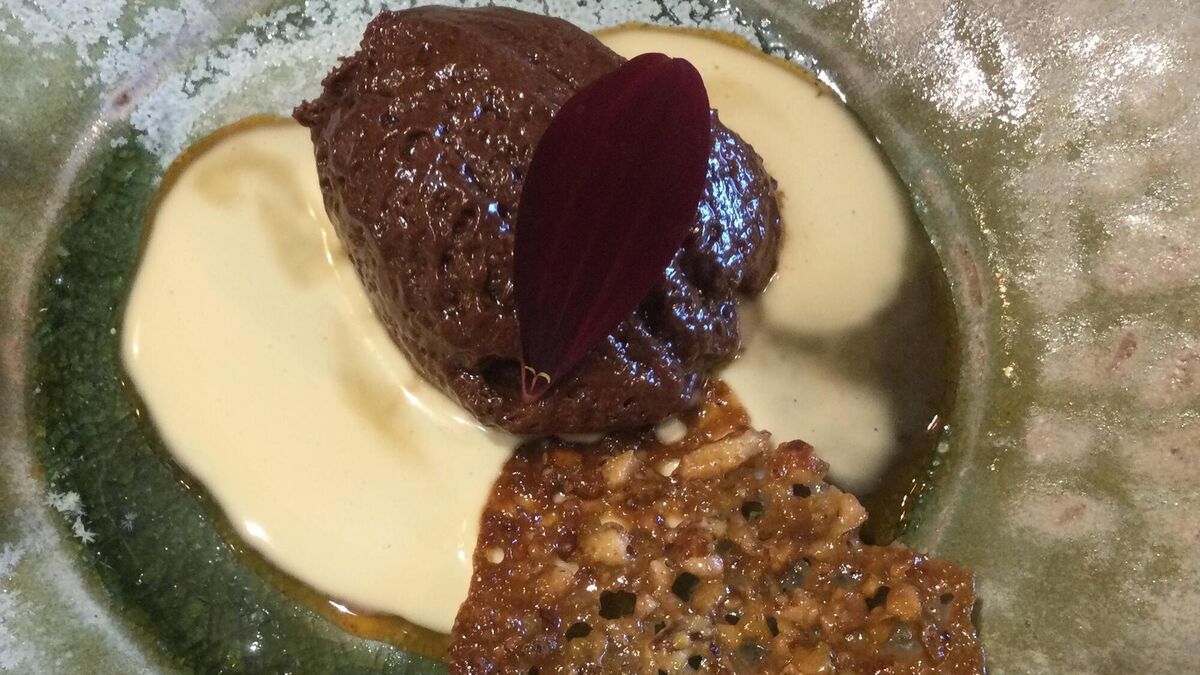
World-leading gut scientist and bestselling author Tim Spector has just published , an accessible introduction to the life-changing benefits of fermentation for both beginners and enthusiasts alike.
The book includes practical tips and some of Tim’s favourite recipes cutting through myths and misunderstanding to help people navigate the fascinating world of ferments and shows how they can help improve our health, our mealtimes and our planet.
- Seek the book out from your local bookshop - published by Penguin Random House UK and don’t miss the ZOE Podcast, it could change your life.
Don’t miss Clodagh at the Pavilion in Ballygarvan, Co. Cork on Saturday, 1st November.
Clodagh has crafted a mouthwatering five-course menu featuring the finest fresh, locally sourced ingredients.
Each dish will be prepared with care by Clodagh, alongside Pavilion Chefs David O'Sullivan and David Rice. Limited places so book early to avoid disappointment.
Day of the Dead celebrations at Picado Mexican, a vibrant cultural series running from October 22 to November 2 at Picado’s new home at The Loom on Cork Street, Dublin 8.
Recognised by UNESCO as part of the Intangible Cultural Heritage of Humanity, El Día de los Muertos (Day of the Dead) is one of Mexico’s most meaningful festivals, a joyful celebration of life, food, and remembrance.
At Picado, the tradition will come to life through a series of cookery workshops, storytelling evenings, and creative events led by Picado’s founder Lily Ramirez-Foran and a collective of Mexican migrant women.
Visitors can expect tamales, sugar skulls, piñata making, supper clubs, and a community open day on the final Sunday, with proceeds from pan de muerto bread and Mexican hot chocolate supporting the Irish Cancer Society.


